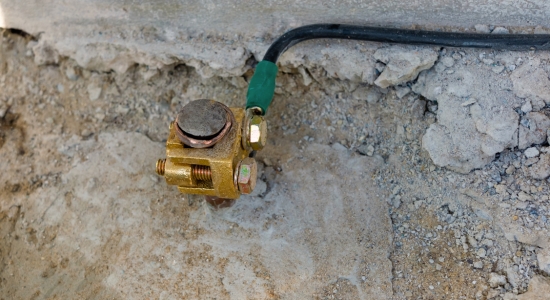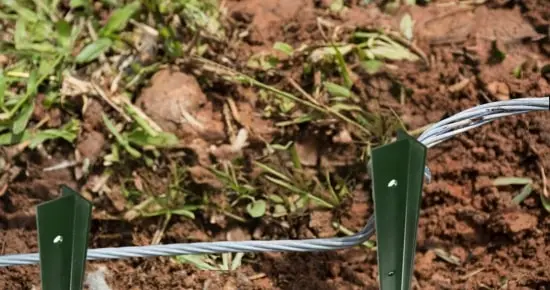Most issues with an electric fence system occur due to inadequate grounding or ground faults. The shock can not be delivered without using quality ground rods wires & connecting back to the energizer’s ground terminal. Hence, it’s necessary to use adequate numbers of highly conductive ground rods treated against rusting.
However, the best option is to use specialized galvanized steel or copper ground rods. You should only use galvanized steel items as ground rods. Why you should not use regular steel for grounding is that it rusts quickly & the protective paint coating inhibits conductivity.
Can You Use a T-post as a Grounding Rod?
Yes, you can use T-posts to ground an electric fence, but they are not as effective as traditional ground rods. T-posts are made of steel and conduct electricity, but their painted or PVC-coated surfaces can act as insulators, reducing conductivity. Additionally, T-posts can only be driven about 3 feet deep, while ground rods should be 6-8 feet deep for optimal grounding. For temporary fencing, galvanized T-posts can be used if driven 3-4 feet into moist soil. However, for permanent fencing, it’s best to use 6-8 feet galvanized steel or copper ground rods to ensure proper grounding and fence effectiveness.
T-posts are thicker than standard ground rods, potentially providing better conductivity by capturing more charges through the soil.
1: Conductivity of T-Posts
T-posts are made of steel, a conductor of electricity, so they can ground an electric fence. However, their effectiveness compared to traditional ground rods is questionable
2: Limitations of T-Posts
Insulation Issues: Most T-posts are painted or PVC-coated to prevent rust, which acts as an insulator and hinders electrical conductivity.
3: Depth Limitation
Ground rods need to be 6-8 feet deep for permanent fencing. T-posts, due to their shape and width, can typically only be driven 3 feet deep, requiring a heavy-duty automatic post driver.
Rust Problems: T-posts rust underground, reducing their effectiveness over time.
4: Suitable Alternatives
Galvanized T-Posts: Only galvanized T-posts or metal rods made of galvanized stainless steel are recommended. Galvanization protects against rust and maintains conductivity.
Temporary Use: For temporary or portable fences, such as animal pens or grazing fields, galvanized T-posts can be used. They should be driven 3-4 feet deep, especially in moist soil.
5: Drawbacks for Permanent Fencing
Insufficient grounding with T-posts can lead to significant power loss, resulting in a weaker fence that risks property or animal safety. For permanent fencing, use 6-8 feet of galvanized steel or copper ground rods.
6: DIY Alternatives
Galvanized T-Posts: These are better than non-galvanized ones as they lack insulating coatings. They have holes for hooking ground wires and last longer against rust. Star pickets T-posts are galvanized & don’t have any protective coating hence they are a good DIY option:
In conclusion, while T-posts can be used for grounding in temporary setups, for permanent fencing, proper galvanized or copper ground rods are essential.
Reasons why T-posts should not be used as electric fence ground rods:
1: T-posts can’t be driven deep into the ground:
The ground rods should be driven 6-8 feet into the ground for permanent fencing. It’s because there is greater moisture deep in the ground that improves current conductivity & helps the leaked charges(electrons) to return to the energizer.
T-posts can’t be used to ground an electric fence because their T(edged) shape & greater width can only be driven up to 3-4 feet. Hence, they can only be used to temporarily ground an electric fence, so there is no issue if some of the charges are lost.

2: The protective coating acts as an insulator & reduces current conductivity:
Although T-posts are made of steel, which is an excellent conductor to prevent rusting, they are mostly painted or PVC-coated instead of galvanized. As paint & PVC are insulators. They make a protective layer around the steel T-post against water & oxygen to prevent rust and hinder the current conductivity. Galvanization is the only rust protection method with the least impact on current conductivity, as the protective layer is made of zinc, which is also a good conductor.
3: Rust also affects current conductivity:
Despite a protective coated layer that acts as an insulator against current conductivity, as compared to being in air, steel, or any metal, rusts & degrades in soil due to moisture, acidic substances & corrosive microorganisms(bacteria). Corrosion also acts as an insulative material, forms a layer around the metal, increases resistance & affects the current conductivity. Hence, it could be better to use T-posts for grounding.
4: Difficult to connect wires to T-posts:
Electric fence ground rods come with a clamp that helps connect the ground wire to the ground rods & to the energizer. T-posts are used as fence posts & they lack the structure to connect an electric wire to them. Hence, connecting the ground wire to the energizers would take much work. Therefore, a loose connection could result in higher resistance & weak circuit connection & power loss in our fence.
Other DIY alternative to electric fence ground rods:
The choice of the ground rod depends on ground conditions, the power of the energizer, and the length of the fence. Ground rods can be made from galvanized stainless steel or copper. For portable, low-power fences, I’ve used and seen others use screwdrivers, rebar, or T-posts as ground rods.
From my experience, aside from specialized ground rods, a galvanized water pipe is an excellent option for temporary or short-area fencing. Drive it at least 1 meter deep. The main benefit of a water pipe is its larger surface area. Additionally, in dry conditions, you can pour water down the pipe or use a funnel to collect dew and rain, helping to maintain moisture deep in the soil.
To ensure your ground rod is effective, test the voltage at the ground rods.
Suggestions as per my experience:
When camping and setting up temporary pens for our horses, I use step-in metal fence posts as grounding rods. I’ve also used galvanized metal posts, rebar, and star picket T-posts effectively for temporary electric fence setups. Galvanized, stainless, or copper materials work well for grounding. However, for permanent field fences, I prefer specialized galvanized steel or copper ground rods.
Ground rods are the least expensive part of a fence system, yet the entire electric fence relies on them. Compromising on ground rods to save money risks the entire fence system and the animals it protects.
While some people use rebar or T-posts as grounding rods, what works for others may not work for you. If you try DIY alternatives, ensure they are galvanized stainless steel to prevent rust and maintain conductivity.
For large areas or livestock, such as cows on extensive land, avoid using T-posts or rebar. Larger areas require a robust electric fence system, and DIY ground rods may compromise its effectiveness.
My advice: don’t cut corners. Do it right the first time to avoid future problems. The money you think you save will be spent fixing issues. Ground rods recommended by the energizer manufacturer are best. Consult the manufacturer or supplier to get suitable ground rods for your energizer, fencing requirements, and ground conditions.
Test if your electric fence has sufficient ground rods:
- After the electric fence circuit is completely installed, turn off your fence energizer.
- Then, move 200-300 feet away from the start of the fence & short out the live fence wire using a metal rod. Make sure the rod touches a live fence wire & the ground rod.
- Similarly, short out the fence at multiple points at regular intervals until the fence voltage drops below or around 2000V.
- Now head toward the ground rods & measure the voltage using a fence tester or an electric fence voltmeter.
- If the voltage is below 300V(some suggest 400-500V), you have installed adequate ground rods. However, if the voltage is above 300-500V, there are not enough ground rods to take the leaked charges back to the energizer & the voltage gathers up at the ground rods.
Tips to effectively ground an electric fence:
- Whether using anything as a ground rod, use 3 feet of ground rod per joule output of your fence charger. However, greater is better. Such as a 10-joule fence charger will need at least 30 feet of ground rods.
- For permanent fencing, each ground rod should be at least 6-8 feet long & driven all into the ground. Due to their large surface area, you’ll need an automatic post driver to drive them 6-8 feet under the ground, as manual tools won’t be helpful if using galvanized T-posts for grounding.
- Each ground rod should be installed 10 feet apart from each other.
- To ensure high current conductivity & prevent power loss, connect the ground rods using highly conductive & insulated wires.
Conclusion
A T post can work as a ground rod, but I will never suggest it. When using an electric fence, you rely on a psychological effect to keep animals or humans from going through. With an insufficiently grounded fencer, animals test fences and get out, or predators get in. Hence, it’s vital to build things properly. Always think you must build an electric fence to protect a million dollars. To ensure the safety & effectiveness of your electric fence, I recommend using specialized galvanized steel rods, galvanized ground rod clamps & ground advice to best help someone with theirs.

